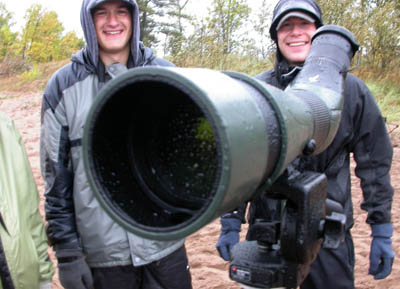
Saturday, September 30, 2006
Friday, September 29, 2006
Thursday, September 28, 2006
More Fall Digiscoping...

White-throated Sparrow
This morning I spent an hour or so digiscoping at Pheasant Branch Conservancy before work. If it's a White-throated Sparrow or Yellow-rumped Warbler that perches on a branch in early morning sunlight directly in front of me at close range, then that's my subject. No matter the bird, I'll give it every bit as much effort in creating the best portraiture I can as I would any coveted feathered gem. The practice of working with the light (it's always about the light) and composition is good experience for honing your field craft. Like anything else worthwhile, the more you do it, the better you'll get.
Though I could see and hear other bird species nearby I would liked to have photographed, I will not chase them down ( I might make an exception for a Fork-tailed Flycatcher!). First light, I'll walk over to a spot near an edge of pre-selected habitat and wait. Naturally, with every outing there will be plenty of missed birds and opportunities. Ones that got away this morning included White-crowned Sparrow, Lincoln's Sparrow, Eastern Towhee and many Ruby-crowned Kinglets. But it was still fun watching them with my binoculars hoping they would come my way.

Yellow-rumped Warbler
Nature photography is about patience, patterns and repetition. By increasing the frequency of your outings you'll improve upon your chances of photographing more species. I'll go through a lot of White-throated Sparrows before obtaining a good shot of a White-crowned, and perhaps through diligence and patience, I'll eventually luck out on a Harris's Sparrow. Seldom do I enter the field intent upon digiscoping a specific species. Sure, I've done it, but the vast majority of birds appearing in my digiscoping gallery are ones that came to where I was standing and waiting.
I choose not to play tape recordings of bird songs to lure them in order to get a picture. I know there are bird photographers who do this and their gallery of species are super impressive. I've heard horror stories about a Black-throated Blue Warbler attacking a photographer's gear on account over-playing song recordings. Photographing birds is challenging, educational and fun. Sharing results with other people can be rewarding, but overplaying tapes to the point of stressing a bird in order to obtain a prized shot is a big waste of time and an unethical practice in my humble opinion. Be patient – the birds will come to you, but it will mean there will be some species you'll never get a picture of. That's probably the way it ought to be.
All images © 2006 Mike McDowell
Wednesday, September 27, 2006
Native American Sparrows

Lincoln's Sparrow
During the past several nights while most of us were snoozing, visitors from far away places have been arriving in our midst - our country's native sparrow species. They've arrived in our backyards, fields and forests, but most of them will only stay for a short while. Here they might spend a few days to rest and fatten themselves up for the next leg of their incredible journey south. But don't confuse these particular sparrows with the exotic House Sparrow transported by us from Europe, no - these are veritable Native American birds and to my eye they are a national treasure to behold.

White-crowned Sparrow
Their journey began from places we've all heard of, like Barrow Alaska, Manitoba and Yukon. Others originated from stranger sounding places such as Tuktut Nogait, La Ronge, Atikaki and Athabasca. Just imagine - some of the birds pictured here may have traveled from as far as north of the Arctic Circle. And just where are they going? The majority of them will spend winter in the southern part of the United States, but many will venture further into Mexico and perhaps even Central America. I consider it a privilege to be graced with their presence for several days each fall season, observing and recording their splendid natural beauty.

White-throated Sparrow
Just a few miles south of Waunakee, there's a unique combination of habitat at Pheasant Branch Conservancy that hosts these sparrows well. It has the precise elements they seek - an edge overlooking a field, shrubby thicket to hide in, tall perches to check for danger, fresh water from a natural spring and plenty of seeds, berries and insects to munch on - a life-saving oasis for an exhausted migrant sparrow.

Harris's Sparrow
I seek these feathered beings each fall - it's sort of like looking in on old friends. I know their habits, habitats, songs and calls - and I know where they'll be. For my part, all I have to do is be present to enjoy the show - it's free and open to the public.Though they sometimes appear to notice me, their lone spectator, mostly they go on about their business of foraging and chasing one another around. In rare cases, I've even witnessed them depart in the evening en masse - a grand exodus for the next leg of migration.

Fox Sparrow
Watching and listening, I cannot help but feel a powerful connection to nature we all can share and enjoy. To see that they are still here is personally reassuring and comforting to me in some way - perhaps things aren't so screwed up for them. Maybe they have a chance at their winter homes, though I know for many thousands of them that this will be their final trip south. Sadder still, this coming spring some of them will travel thousands of miles north only to discover that their stop-over points and summer homes have vanished.
Enjoy our native sparrows - they deserve our protection.
All images © 2006 Mike McDowell
Tuesday, September 26, 2006
Monday, September 25, 2006
Working Cats
Cats With Jobs.
If you want to keep your pets safe try a pet insurance comparison and get the most bang for your buck!












If you want to keep your pets safe try a pet insurance comparison and get the most bang for your buck!












The Jaeger Hunters

Jesse scopes for jaegers
The 2006 WSO Wisconsin Point Trip was the best one yet! I rode up with Jesse Peterson, Aaron Stutz and Tom Prestby on Thursday night. Given reports of jaegers earlier in the week, our expectations were high and we were generously rewarded for enduring some very rough weather. Though we saw many great birds over the weekend, my personal highlight was an incredible look at a lifer Pomarine Jaeger at about 30 yards away.
The weather on Friday and Saturday was exceptionally grim – 30 to 40MPH winds and pelting rain. This was sort of a mixed bag – on the one hand it meant great opportunities for bringing in jaegers and rare gulls, but there were several optics casualties. One barrel is completely internally fogged on my Swarovski 8x30 SLC’s and will have to be sent in for repair. A few scopes were unable to weather the storm as well, including a B&L Elite, Jesse's Zeiss zoom lens and an EO Raven.

Tom and Aaron survey Tom's drenched scope
My Swarovski scope got completely soaked, as did Tom's, but neither one of us had any problem with internal fogging. Pictured above, Tom and Aaron are looking at Tom's drenched scope. Below is a picture of Tom Schultz, WSO field trip leader, tending to his scope.

Tom Schultz cleans his objective lens
Luckily for me, Tom Prestbly's Dad arrived on the scene Saturday afternoon with a pair of EO Rangers he loaned me that dutifully held up in the rain. When the sun finally returned on Sunday, I switched to my Nikon Superior E's. Unfortunately, birds we were hoping to view in comparative comfort had apparently left with the change in weather – we went jaeger-less on Sunday.


Return of the Sun!
We had around 80 species for the trip, but I think the 5-day total for the "early birders" was something closer to 140. New birds for the year for me were:
Surf Scoter – WI YEAR
Sharp-tailed Grouse - LIFE
Sanderling – WI YEAR
Parasitic Jaeger – WI YEAR
Long-tailed Jaeger - LIFE
Pomarine Jaeger - LIFE
Little Gull – WI LIFE
Sabine's Gull – WI YEAR
Common Tern – WI YEAR
American Pipit – WI YEAR
Harris's Sparrow – WI YEAR
Red Crossbill – WI YEAR

I wasn't able to get on the Long-tailed Jaeger fast enough to identify it by plumage characteristics, but it's flight behavior and Jesse’s field mark descriptions (he saw it when it was much closer) were enough for me to add it, but hopefully I'll manage a better look next year. Nevertheless, it sure helped to read Olsen and Larsson's skua and jaeger guide before this trip. There were only a few jaegers that were either in poor light or too far away for us to identify, which is a good reminder that not all of them can be.
I was pretty thrilled to confidently distinguish differences between a juvenile dark morph Pomarine Jaeger and a juvenile dark morph Parasitic Jaeger that flew past us at close range within a few minutes apart – a nice visual comparison of flight behavior and plumage characteristics. In one excellent demonstration of jaeger behavior, I watched an adult light morph Parasitic Jaeger harass a Ring-billed Gull until it either dropped or regurgitated food – the jaeger caught it midair and made off with its pirated meal. Three gulls then chased the successful jaeger as it made a beeline back out to open water.
Getting a little waterlogged and worn from the adverse weather, on Saturday afternoon we scoped for ducks at Allouez Bay from the comfort of the pinewoods which blocked the wind. Within a few minutes Aaron found an adult light morph Parasitic Jaeger floating on the water! We radioed it in and many other birders joined us. The jaeger zoomed around the bay a few times but would return to the water – sometimes preening other times just resting. After harassing a few Ring-billed Gulls and coming up with nothing, the jaeger gave an excellent fly-over look as it headed out to Lake Superior.
Sunday morning we walked out to the Wisconsin Point Lighthouse and stayed long enough to find a pair of adult winter plumaged Little Gulls. We wanted to make a few stops on the way home for other northwoods specialties (Red Crossbills, Sharp-tailed Grouse, etc.), so we left the Point mid-morning.

Wisconsin Point Lighthouse
Pied-billed Grebe
Double-crested Cormorant
Great Blue Heron
Tundra Swan
Canada Goose
Wood Duck
Mallard
Redhead
Surf Scoter
Common Merganser
Turkey Vulture
Osprey
Bald Eagle
Sharp-shinned Hawk
Red-tailed Hawk
Ameican Kestrel
Merlin
Peregrine Falcon
Ruffed Grouse
Sharp-tailed Grouse
Black-bellied Plover
American Golden Plover
Spotted Sandpiper
Sanderling
Baird's Sandpiper
Parasitic Jaeger
Long-tailed Jaeger
Pomarine Jaeger
Little Gull
Bonaparte's Gull
Ring-billed Gull
Herring Gull
Lesser Black-backed Gull
Sabine's Gull
Caspian Tern
Common Tern
Rock Pigeon
Mourning Dove
Belted Kingfisher
Yellow-bellied Sapsucker
Hairy Woodpecker
Northern Flicker
Eastern Phoebe
Blue Jay
American Crow
Common Raven
Black-capped Chickadee
Red-breasted Nuthatch
Brown Creeper
Golden-crowned Kinglet
Ruby-crowned Kinglet
Eastern Bluebird
Gray-cheeked Thrush
Swainson's Thrush
Hermit Thrush
American Robin
American Pipit
European Starling
Blue-headed Vireo
Yellow-rumped Warbler
Black-throated Green Warbler
Palm Warbler
American Redstart
Ovenbird
Northern Waterthrush
Eastern Towhee
Clay-colored Sparrow
Vesper Sparrow
Song Sparrow
Lincoln's Sparrow
Swamp Sparrow
White-throated Sparrow
White-crowned Sparrow
Harris's Sparrow
Dark-eyed Junco
Lapland Longspur
Rusty Blackbird
Common Grackle
Red Crossbill
Pine Siskin
American Goldfinch
All images © 2006 Mike McDowell
Sunday, September 24, 2006
Subscribe to:
Comments (Atom)








































